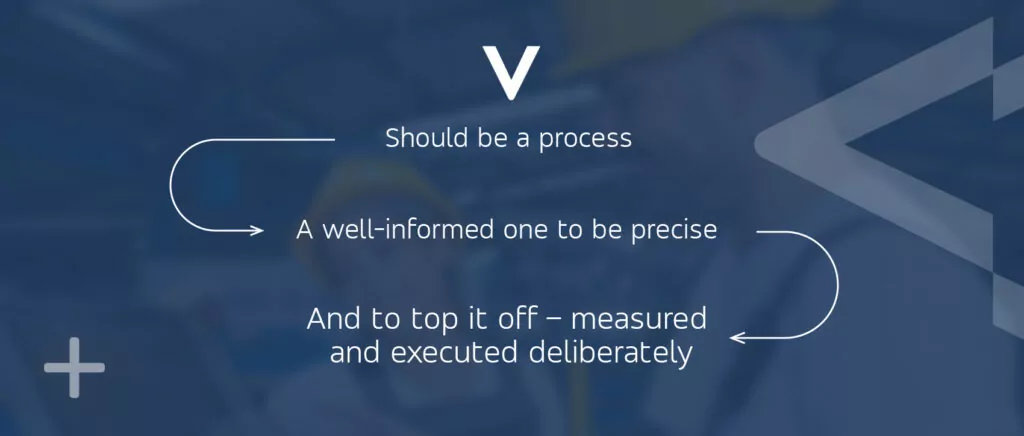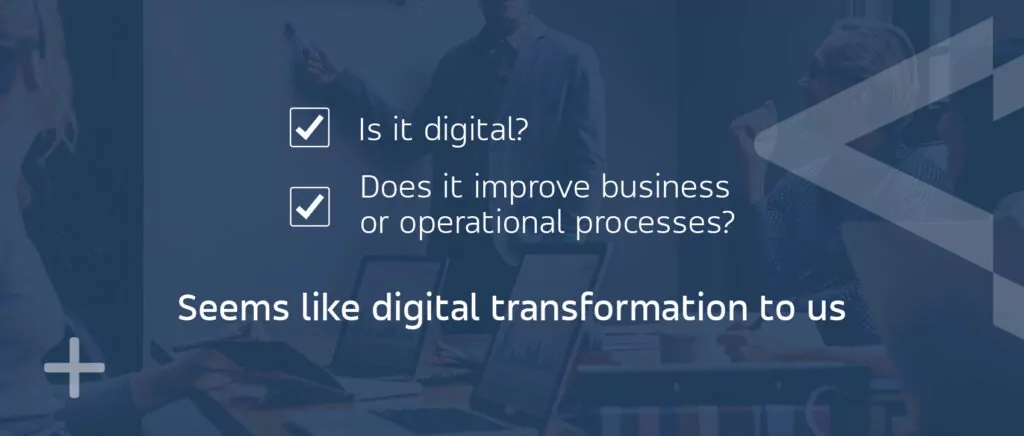Digital transformation serves particular purposes. What could these purposes be? Since the process of employing the newest technologies in organizations is aimed at reimagining business in the digital era, the goal of said transformation can’t be something trivial.
Digital transformation and how should it be done
On many occasions before we’ve mentioned that – in the perfect world – the transformation…

There’s no time to waste in the global market – grab your processes and get in the car, we’re going to transform.
We’ve already focused our attention on reducing costs thanks to including digital solutions and this time, we’d like to show you how to improve process effectiveness. With digital transformation, of course.
How to decide whether an industrial or business process needs improvement?
It may require a bit more than just a hunch to identify the right area for improvement. Among tools helpful in assessing them we can list:
Analysis
Business operations generate a lot of data. Applying statistical and/or logical techniques allows us to evaluate the bigger picture emerging from it. Tools like operational surveys, process mapping, and cause analyses enable the precise identification of bottlenecks and trouble spots.
Audits
The examination of a company’s reports and books can give unambiguous answers on areas for improvement, potential pain points, and risks. Audit results should allow for preparing a strategy on the necessary process improvement steps and prioritization of particular stages.
Key Performance Indicators (KPI)
The business approach shouldn’t change things for the sake of changing, that’s why indicators are necessary. Said meters measure the performance of investigated processes and help assess the results of actions.
Benchmarks
Benchmarks are reference points against which the taken measures and their results are compared. Depending on needs and particular processes, benchmarks can apply to the competition, industry standards, and trends. Setting reference points helps assess the performance and identify further deficiencies to address.
Which processes can be suspected to lack effectiveness in the first place?
- These that worked well when the company was ¼ of its present size
- These that were sufficient when the telex was the latest fashion
- These that require way too much attention or energy compared to the value they add
- These that are unnecessarily done manually
Inefficient processes are often rooted in similar causes, including fear of innovation, the force of habit, and the consequent attachment to outdated solutions.
How does digital transformation improve process efficiency?
Faulty processes are an Achilles’ heel of the organization. While temporary setbacks may happen everywhere, once a problem persists, permanent damage to the company’s operational efficiency may occur.
Improving efficiency with digital solutions has many faces. Sometimes, it may mean as much as introducing better channels of communication. In an organization where employees spend too much time writing emails, making phone calls, or sitting in meetings, the process can be streamlined with digital communication tools.
In another case, process effectiveness can be improved with automation. When operations require staff to perform repetitive tasks, ceding work to technology can free the workforce to focus on other, more demanding activities. This does not apply only to fields like industrial manufacturing, more associated with the newest technologies. Administrative and office tasks can equally well be automated. Printing, scanning, archiving extensive binders full of files? That’s not just a waste of paper and storage space, but the most valuable resource – time.
As the office case shows, improving processes doesn’t need to mean full-blown digitization from Day 1. Digital transformation can be successfully handled in stages. Let’s take as an example invoice processing.

This way, effectiveness can be measured, personnel has time to adapt to new processes, and the structure functions smoothly without disruptions.

How does it look from a digital service provider perspective?
Usually, there are a few scenarios possible. Either the company has traditional processes and requires digitalization, or some operational areas are already digital (or partially digital), but are unsuited to the needs. Or, the process on the clients’ side needs both digitalization and optimization. While each situation requires different solutions, the cooperation has similar conduct in all of them.
Starting with the overarching question: How could you improve a process with digital transformation?, we begin with the analysis of the company’s operations. Only after getting to know its needs and requirements, together we choose processes for digitalization. While drafting a strategy, we agree on subsequent stages to follow during its implementation. As digital transformation is not an all-or-nothing undertaking, we decide on MVPs and the criteria for their assessment.
Before we introduce improvements into the company’s structure, it’s time to engage its personnel. Changes need not only to be announced but also the staff should – and in many cases, can – be involved in the process. While data gives valuable insights into core operations, asking daily users for their feedback and ideas on what to improve can shorten the time needed to come up with a working solution.
Without knowing where we’re heading it would be hard to decide if we’ve made it there, thus measuring the digital transformation requires adequate meters. This is also the time to consider A/B testing. Split testing of two or more variants helps us to assess which version performs better. If the existing method falls short compared to available alternatives, it’s time to consider improvements. Each improvement can undergo A/B testing again until the right solution is in place.
Digitalization doesn’t end with taking the nearest technology and throwing it in the middle of a working structure. Changes resulting from the transformation can take more time and thus will require proper management. We say this to emphasize that most technologies can’t be treated as miracle cures and be left to do wonders unsupervised. It’s the other way around. Once the digital enhancements aimed at improving process effectiveness are ready for operation, it’s time to observe, measure, and, if necessary – improve the solution. The strategy for improving processes can change in the course of action and thus, should be observed.
The first pancake is always spoiled
Not necessarily, no. Beginnings may be challenging, especially for organizations that have been functioning traditionally. It does however get better with time. What we wholeheartedly advise is to engage in the transformation process with moderation and avoid a hype-driven revolution.
Digitalizing a single, standalone area within the enterprise is a good starting point. When we turn the whole structure upside down in most cases it will cause chaos. Instead, minor changes can bring significant improvements – when carried out properly. In addition, going for the low-hanging fruit can be a great start to the transformation. Identifying processes that are easily digitalized and produce excellent results will encourage the company to move to the next stages.
Some distinguish digital transformation from digital improvement, but when it comes to tangible results, we won’t argue about semantics. That’s true, some changes may not seem spectacular when looking from the outside, yet they bring satisfactory results. Even if the digital enhancement may seem too isolated from a full-blown transformation, it’s the result that matters.

Risk of poor process improvement
Change is always burdened with risk, and so is the implementation of new solutions. Proper preparation, not only in terms of the sole process but also of the staff is necessary. What needs to be emphasized is that introducing technology into operations shouldn’t be feared by personnel. Actions ceded to digital solutions will unburden the workforce and allow to relocate the resources within the company. As a result, staff can take on more demanding tasks instead of continuing repetitive work.
The takeaway
Digital transformation is not an extreme home makeover. It doesn’t happen overnight, giving instant and spectacular results. But let us tell you something – it’s better this way. Improving process effectiveness with digital transformation requires attention, analysis, and expertise, and as such – brings tangible, lasting results.
A well-thought-out and well-informed change is certainly worth a shot in the dynamically changing world. Do you want to learn more? You can drop us a line and book your one-hour free consultation, where we’ll dwell on your needs and what our team can do to be the digital transformation partner you need. Up for some more reads? See what we have in store for you and find out more about whether your company is ready for digital transformation, what digital transformation actually is, and how does it turn out in particular industries, like the healthcare field.





